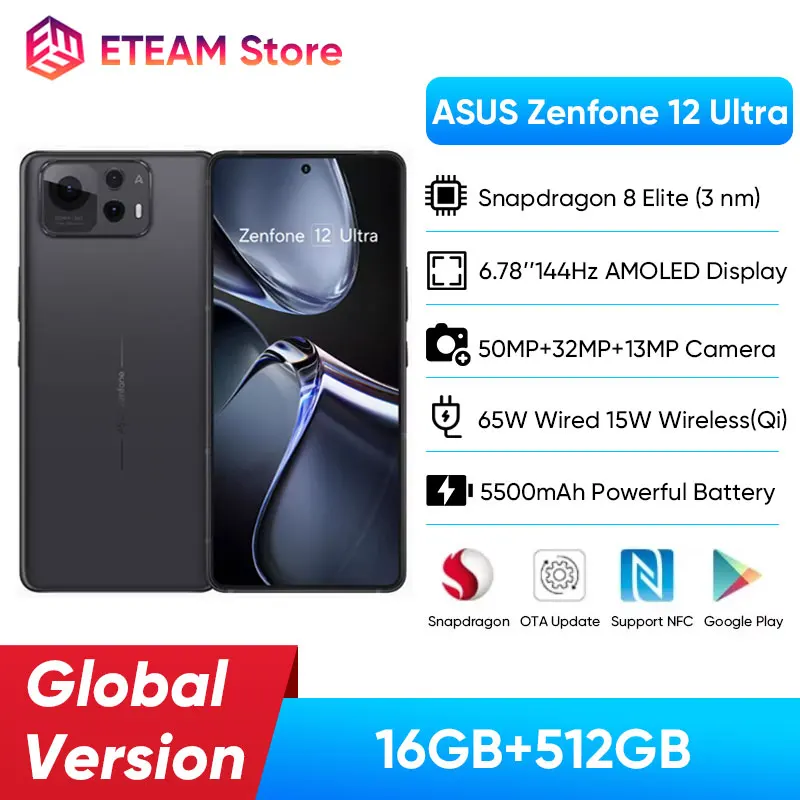ASUS Zenfone 12 Ultra is the latest model in the Zenfone line, with a large RAM capacity and a cutting-edge chipset. As the successor of last year’s Zenfone 11 Ultra, the Zenfone 12 Ultra has a Vibrant 6.78-inch 120Hz AMOLED display, the latest Snapdragon 8 Elite chipset, a triple-camera setup, including a 50MP Sony Lytia 700 camera sensor. It also packs a 5,500 mAh pack with 65W HyperCharge support and Qi 1.3 wireless charging.
Asus Zenfone 12 Ultra Key Specs and Features
- 6.78 inches LTPO AMOLED Display, 1080 x 2400 pixels (~388 ppi density), ~88.0% screen-to-body ratio
- Android 15, up to 2 major Android upgrades
- Qualcomm SM8750-AB Snapdragon 8 Elite (3 nm) Octa Core Processor
- 12GB, 16GB RAM
- 50 MP (wide) + 32 MP (telephoto) + 13 MP (ultrawide) Triple Rear Camera
- 32 MP Front Camera
- Fingerprint Sensor (under display, optical)
- Dust and Water Resistance (IP68)
- 256GB, 512GB Built-in Storage
- 4G LTE Support
- 5G Support
- Wi-Fi 6e and Wi-Fi 7 Support
- 65W Fast Charging Capacity
- 15W Fast Wireless Charging Capacity
- 5500 mAh Battery
Design
The ASUS Zenfone 12 Ultra carries a design that stays largely consistent with its predecessor, the Zenfone 11 Ultra. The phone’s blocky structure is complemented by a combination of materials that create a premium, durable feel.
The front of the device is constructed with glass, while the aluminum frame adds a modern touch. The back is covered in a matte glass that, while visually appealing, can be difficult to keep clean due to its tendency to attract fingerprints and smudges. This matte finish, however, offers a solid grip, preventing the phone from slipping out of your hands easily, a feature that becomes even more pronounced when used without a case.
Measuring 183.8 x 77 x 8.9 mm and weighing 220g, the Zenfone 12 Ultra is a sizable phone that might not be ideal for users who prefer compact devices. However, the build quality ensures durability, as the phone boasts an IP68 rating, which means it is dustproof and resistant to water submersion, offering peace of mind in potentially hazardous conditions.
Furthermore, Asus has made an effort to incorporate sustainability into the design by utilizing 100% recycled aluminum for the frame and 22% recycled glass for the display, showcasing the brand’s commitment to reducing its environmental impact.
On the front, the ASUS Zenfone 12 Ultra features a large display with slightly curved edges, giving the device a more modern, sleek appearance. The thin bezels around the screen contribute to an immersive viewing experience, although the most notable feature is the punch-hole cutout for the selfie camera.
Interestingly, the punch-hole is larger than the actual camera lens, which seems a bit disproportionate but doesn’t take away from the overall aesthetic. The in-display optical fingerprint reader is another positive design choice, providing a fast and reliable unlocking mechanism, positioned comfortably for easy access.
The rear design of the phone sees some refinement in comparison to the previous model. The camera module has been made smaller and now adopts a cleaner, more minimalist approach by eliminating the geometric pattern found on the Zenfone 11 Ultra.
Despite the upgrade to the gimbal stabilizer inside, the camera module still protrudes slightly, although the reduced size makes it less intrusive. The glass back with its silky matte finish gives the ASUS phone a more polished and sophisticated appearance, although it does tend to accumulate fingerprints and smudges just as easily as the front.
In terms of physical controls, the right edge houses the power button, which is placed in an easy-to-reach position, even for a phone of this size. However, the volume rocker is located a bit higher up, which may require some stretching for users with smaller hands. The fingerprint sensor, integrated into the display, is positioned slightly higher than typical phones, which may take a bit of getting used to but doesn’t pose any significant inconvenience.
The Zenfone 12 Ultra is available in three color options: Ebony Black, Sage Green, and Sakura White (which is actually more of a pinkish hue). These colors offer a variety of choices to suit different tastes, and the subtle tones help the phone maintain a sophisticated look without being overly flashy.
Display
The display of the Asus Zenfone 12 Ultra is one of its standout features, offering a large 6.78-inch screen that really makes the device feel sizable in the hand. This large display may be a bit of a stretch for users with smaller hands, but it’s ideal for those who prioritize immersive media experiences.
The panel itself is an 8-bit E6 Samsung Flexible AMOLED, a high-quality display that delivers deep blacks and vibrant colors. The screen resolution is FHD+ (1080 x 2400), which is fairly standard in most modern smartphones, but at this price point, some users might expect a higher resolution, like Quad HD. Despite this, the FHD+ resolution still provides sharp visuals and clear text for most tasks.
One of the most impressive aspects of the Zenfone 12 Ultra’s display is its dynamic refresh rate capabilities. With the help of LTPO (Low-Temperature Polycrystalline Oxide) technology, the phone can adjust its refresh rate between 1Hz and 120Hz, depending on the activity.
This means that during regular usage, the 5G phone can conserve battery by reducing the refresh rate when you’re simply reading static content, while still providing smooth, fluid animations and scrolling when needed.
The display can even go as high as 144Hz while playing certain games, enhancing the experience for gamers who want the smoothest gameplay possible. This dynamic refresh rate not only improves visual fluidity but also contributes to better battery efficiency, especially with the 1Hz low end helping to save power during less demanding tasks.
Therefore, the Zenfone 12 Ultra offers three refresh rate modes for customization: 60Hz, 120Hz, and Auto. The 60Hz mode is fairly self-explanatory and offers a more power-efficient experience. The 120Hz mode ensures a consistently smooth experience, particularly when navigating the UI and interacting with apps.
The Auto mode utilizes the dynamic refresh rate switching that adjusts from 1Hz to 120Hz based on the content on screen, even dropping to 5Hz when the phone is idle for a few seconds to save power.
It’s worth noting that in Auto mode, the phone can also drop down to 60Hz when playing videos, which is different from the 120Hz mode, where the refresh rate stays consistently higher for a smoother video experience.
In terms of brightness, the display doesn’t disappoint either. It can peak at an impressive 2500 nits when viewing HDR content, ensuring that the screen remains legible and vibrant even in direct sunlight. This is especially valuable for outdoor use, where visibility is often a challenge for smartphones with lower brightness capabilities.
The Zenfone 12 Ultra also comes equipped with the highest Widevine L1 certification, allowing for Full HD streaming from services like Netflix and other video platforms.
Additionally, the phone supports hardware decoding for HDR10, HDR10+, and HLG formats, providing vibrant and high-quality video playback, though it does not support Dolby Vision, which may be a disappointment for some users who are accustomed to Dolby Vision’s superior color and contrast depth.
Camera
The camera system on the Asus Zenfone 12 Ultra offers significant upgrades and refinements over its predecessor, though some aspects remain familiar.
The main camera retains a 50MP sensor, but it has been switched from the Sony IMX890 (Lytia 701) in the Zenfone 11 Ultra to the new Sony IMX906 (Lytia 700). While this may seem like a modest upgrade, it represents a “sidegrade” as the IMX906 sensor is built to offer more refined video capture and enhanced stability through improved gimbal stabilization.
This sensor is paired with version 4.0 of Asus’s 6-axis hybrid gimbal system, which is one of the key highlights of the Zenfone 12 Ultra. The gimbal system now offers up to 5 degrees of correction and vibration compensation, a 66% improvement over the previous version, making it even more effective at stabilizing shots and ensuring smoother video recording, particularly in dynamic environments.
The Zenfone 12 Ultra also carries the same auxiliary cameras as the Zenfone 11 Ultra. It includes a 13MP ultrawide angle camera with a 120° field of view, which is ideal for wide landscape shots and group photos, as well as a 32MP telephoto camera with Optical Image Stabilization (OIS) and 3x optical zoom. The telephoto camera’s high resolution and OIS ensure that you can capture distant subjects with impressive clarity and minimal blur.
For selfies and video calls, there’s a 32MP RGBW camera on the front, which can deliver bright and clear images, especially in low-light conditions thanks to its RGBW sensor, which improves color accuracy and light sensitivity.
In terms of video capabilities, the Zenfone 12 Ultra makes a strong case for content creators and videographers. The main camera supports video recording up to 8K resolution at 24fps, as well as 4K at 30/60fps and 1080p at various frame rates (30/60/120/240fps).
Additionally, the phone supports HDR10+ for rich, vibrant video playback, and gyro-EIS for enhanced stabilization during video recording. This means that whether you’re shooting in ultra-high-definition or simply capturing smooth, slow-motion footage, the Zenfone 12 Ultra is well-equipped to handle the task.
As for the camera app, it hasn’t seen any major overhauls, but there are a few useful additions, such as the new document scanning feature and an easier way to trigger the timer.
The app also includes a number of AI-assisted shooting modes, which automatically optimize the settings for different types of scenes, ensuring subjects are always in focus and well-exposed. A small scene icon appears in the top left corner of the screen when the camera detects the type of scene it’s capturing.
Additionally, the Night Mode UI now automatically pops up in the bottom right corner when the camera determines it’s dark enough to warrant a low-light enhancement. The Night Mode also provides two options for exposure duration, which gives users more control over how long the camera takes to expose an image in darker environments.
For those who prefer manual control over their photography, the Zenfone 12 Ultra offers a Pro mode, which allows adjustments to white balance, exposure compensation, ISO, shutter speed, and even a manual focus slider with focus peaking for more precise focus control.
There’s also a Pro video capture mode for more in-depth control over video settings, making the Zenfone 12 Ultra a versatile option for users who want to take their photography and videography to the next level.
Hardware and Software
The Asus Zenfone 12 Ultra lives up to its “Ultra” moniker with cutting-edge performance, thanks to the integration of the Qualcomm Snapdragon 8 Elite chipset. This 3nm chipset is packed with top-tier features and advanced connectivity options, offering remarkable upgrades across the board compared to the previous model.
The Snapdragon 8 Elite boasts a powerful CPU configuration, with two high-performance 4.32 GHz Oryon V2 Phoenix L cores and six energy-efficient 3.53 GHz Oryon V2 Phoenix M cores, making it well-suited for demanding tasks and multitasking.
Paired with the Adreno 830 GPU, this setup provides a significant boost in graphical performance, delivering smoother gameplay and faster rendering of graphics-intensive apps.
Asus claims that the Snapdragon 8 Elite brings a 45% increase in CPU performance, a 40% improvement in GPU performance, and a 40% gain in NPU (Neural Processing Unit) performance over the Zenfone 11 Ultra, making it a powerful powerhouse for gaming, productivity, and AI tasks.
In terms of thermal management, the Zenfone 12 Ultra impresses with its ability to handle heat during intensive tasks such as gaming or video recording. Thanks to a well-designed cooling system, the device maintains consistent performance without significant throttling or overheating, even during prolonged use.
In terms of memory and storage, the Zenfone 12 Ultra offers two configurations: 256GB of storage paired with 12GB of RAM or 512GB of storage with 16GB of RAM. Both configurations use UFS 4.0 storage, ensuring blazing-fast read and write speeds for smooth app launches, file transfers, and overall system responsiveness. While there is no expandable storage via a microSD card slot, the internal storage options should be more than sufficient for most users, providing plenty of space for apps, media, and files.
As far as software goes, the Zenfone 12 Ultra runs a relatively clean version of Android 15. Asus promises at least two major software updates and five years of security patches, which is a strong commitment to keeping the phone up-to-date and secure for years to come.
The integration of AI features is more pronounced than ever, with the Zenfone 12 Ultra leveraging Meta’s Llama 3 8B language model to provide enhanced on-device AI summarization, real-time translation, and semantic search.
These features work entirely on-device, ensuring privacy and faster performance, as there is no need to rely on cloud processing for these tasks. Additionally, AI-powered transcribing, document summaries, and article summaries combine both cloud and on-device AI, offering versatility while maintaining efficiency in regular use.
While some of these AI features are carryovers from the Zenfone 11 Ultra, others are brand new. Asus allows users the flexibility to choose whether to rely on cloud computing or not for certain AI tasks, providing an added layer of customization based on personal preferences. Asus has also stated that, for the time being, these cloud services will remain free of charge, which adds value to the overall experience without any hidden costs.
Despite its impressive performance, the Zenfone 12 Ultra is equipped with a large 5500mAh battery. This is split into dual 2750mAh cells and supports fast charging via the USB PD 65W protocol.
Asus claims that the phone can be charged to 100% in just 39 minutes, making it incredibly efficient for users on the go. The device also supports 15W wireless charging (Qi) and 10W reverse wireless charging, allowing you to charge other devices or accessories using the phone itself. The battery size and charging capabilities ensure that the phone can handle heavy usage throughout the day, with fast refueling speeds for minimal downtime.
One of the standout features of the Zenfone 12 Ultra’s chipset is the support for Qualcomm’s latest suite of technologies, including the AptX HD and AptX Lossless audio codecs. These codecs enhance the audio experience, especially when using compatible Bluetooth headphones or speakers, delivering higher-quality sound without sacrificing efficiency.
The Asus Zenfone 12 Ultra is equipped with Wi-Fi 7 for ultra-fast wireless speeds, alongside tri-band support for improved network performance. Additionally, the Android phone includes a USB Type-C port, NFC support, and cutting-edge wireless connectivity options, making it a versatile choice for users seeking high-performance audio and seamless connectivity. It also features Bluetooth 5.4 for better connectivity and supports 32-bit/384kHz Hi-Res audio and Hi-Res wireless audio for top-tier sound quality.
Where to Buy ASUS Zenfone 12 Ultra
Amazon UK – See Offers | AliExpress – See Offers
ASUS Zenfone 12 Ultra Price and Availability
ASUS Zenfone 12 Ultra price starts at around $1,019.00 at leading retailers. The model with 16GB RAM and 512GB ROM retails for 1,078.28 EUR and 962.51 GBP on Amazon stores in Germany and the United Kingdom, respectively.



ASUS Zenfone 12 Ultra Specs
Here are a few specs of the Asus Zenfone 12 Ultra:
General Features
- Platform: Android 15, up to 2 major Android upgrades
- Processor: Qualcomm SM8750-AB Snapdragon 8 Elite (3 nm) Octa Core Processor (4.32 GHz dual-core Oryon V2 Phoenix L and 3.53 GHz Hexa-core Oryon V2Phoenix M)
- GPU: Adreno 830
- Memory: 12GB, 16GB RAM
- Colors: Ebony Black, Sakura White, Sage Green
- Dimension: 163.8 x 77 x 8.9 mm
- Weight: 220 g
- SIM Type: Nano SIM, eSIM
- SIM Count: Dual-SIM
Display
- Display: 6.78 inches LTPO AMOLED Display, 1080 x 2400 pixels (~388 ppi density), ~88.0% screen-to-body ratio, 144Hz Refresh Rate, HDR10, 1600 nits (HBM), 2500 nits (peak) Brightness
- Screen Protection: Yes, Corning Gorilla Glass Victus 2
- Foldable Display: No
Camera
- Rear Camera: 50 MP (wide), f/1.9, PDAF, gimbal OIS + 32 MP (telephoto), f/2.4, PDAF, OIS, 3x optical zoom + 13 MP (ultrawide), f/2.2, 120˚ FoV Triple Camera
- Rear Camera Features: LED Flash, HDR, Panorama, 8K@24fps, 4K@30/60fps, 1080p@30/60/120/240fps, 720p@480fps; gyro-EIS, HDR10+
- Front Camera: 32 MP (wide) f/2.5 Camera, Panorama, HDR, 1080p@30fps
Storage
- Built-in Storage: 256GB, 512GB
- Memory Card Support: No
- Bundled Cloud Storage: –
Network Support
- 2G GSM: GSM 850 / 900 / 1800 / 1900
- 2G CDMA 1X: –
- 3G WCDMA: HSDPA 800 / 850 / 900 / 1700(AWS) / 1900 / 2100
- 3G CDMA EVDO: –
- 4G LTE: Yes, LTE Bands 1, 2, 3, 4, 5, 7, 8, 12, 17, 18, 19, 20, 25, 26, 28, 32, 34, 38, 39, 40, 41, 42, 43, 48, 66
- 5G: Yes, 5G Bands 1, 2, 3, 5, 7, 8, 12, 18, 20, 25, 26, 28, 38, 40, 41, 48, 66, 77, 78, 79 SA/NSA
Internet and Connectivity
- GPRS: Yes
- EDGE: Yes
- 3G/WCDMA/HSPA: Yes
- HSPA+: Yes
- CDMA EVDO: –
- 4G LTE: Yes
- 5G: Yes
- WLAN: Yes, Wi-Fi 802.11 a/b/g/n/ac/6e/7, WiFi 6e, Wi-Fi 7, tri-band, Wi-Fi Direct
- Wi-Fi Hotspot: Yes
- Bluetooth: Yes, Bluetooth 5.4, A2DP, LE, aptX HD, aptX Adaptive, aptX Lossless
- NFC: Yes
- Infrared Blaster: –
- USB Port: Yes, USB Type-C
Messaging
- SMS/MMS: Yes
- Instant Messaging: Yes
- Push Emails: Yes
- Email Protocol: –
Entertainment
- Music Player: Yes
- Video Player: Yes
- FM Radio: –
- Loudspeaker: Yes, with stereo speakers
- 3.5mm Jack: Yes
Navigation
- Navigation: Yes, GPS (L1+L5), BDS (B1I+B1c+B2a), GALILEO (E1+E5a), QZSS (L1+L5), NavIC, GLONASS
- Maps: Yes
Sensors and Control
- Digital Compass: Yes
- Accelerometer: Yes
- Proximity Sensor: Yes
- Light Sensor: Yes
- Barometer: –
- SpO2: –
- Pedometer: –
- Heart Rate Monitor: –
- Gyroscope: Yes
- Fingerprint Scanner: Yes, (under display, optical)
- Iris Scanner: –
- Face Unlock: –
- Stylus Pen: –
- Intelligent Digital Assistant: Yes
- Motion Sensing / Gesture Control: –
- Voice Control: Yes
Other Features
- Video Streaming: Yes
- Active Noise Cancellation: Yes
- Wireless Charging: Yes, 15W Wireless Charging
- Built-in Mobile Payment: –
- Water Resistant: Yes, IP68 (survives in up to 1.5 meters of fresh water in up to 30 minutes)
- Dust Resistant: Yes, IP68
- Image Editor: Yes
- Video Editor: Yes
- Document Viewer: –
- Document Editor: –
Battery
- Battery: 5500 mAh Battery
- Talktime: –
- Standby Time: –
- Fast Charging: 65W Fast Charging Capacity, 15W Fast Wireless Charging Capacity







